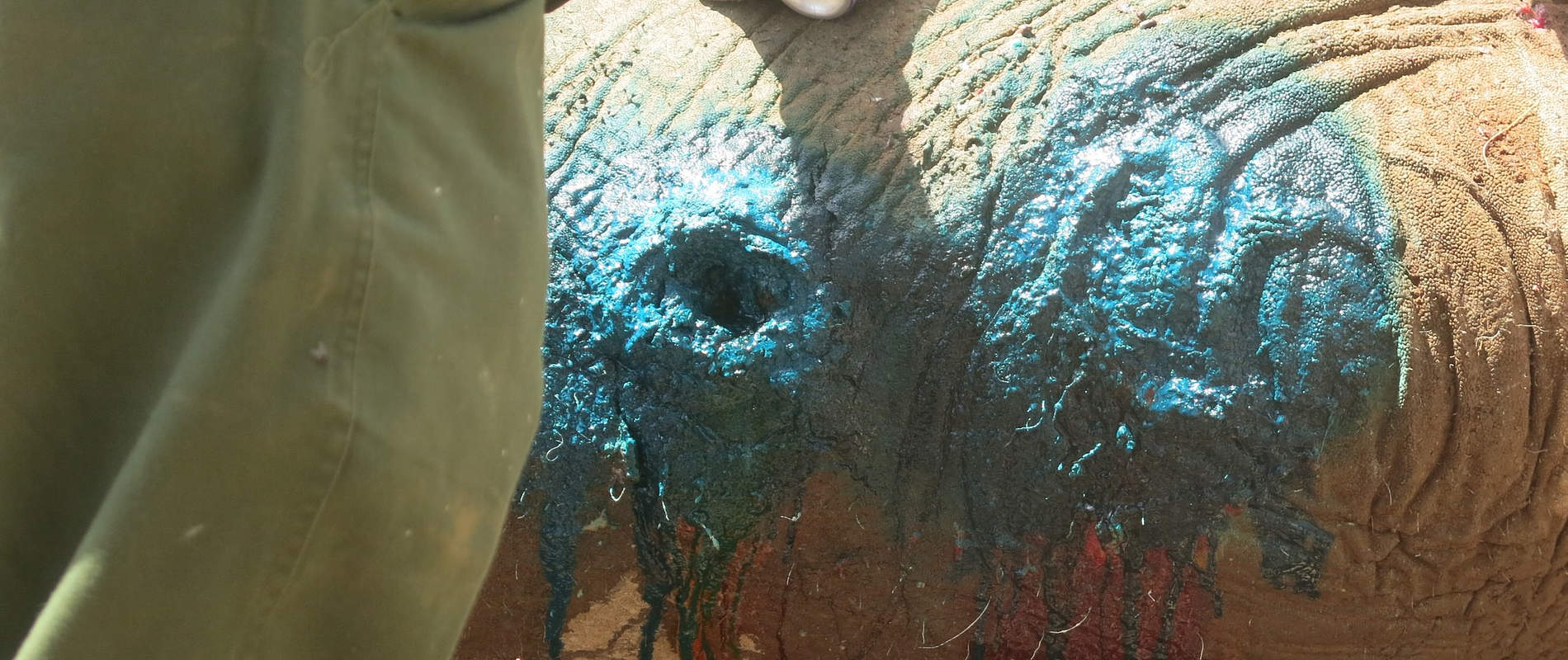EASTERN CONSERVATION AREA VETERINARY UNIT MONTHLY REPORT FEBRUARY 2017 Report by: Bernard Rono Summary This report describes activities of the Meru Veterinary Unit in February 2017
EASTERN CONSERVATION AREA VETERINARY UNIT MONTHLY REPORT FEBRUARY 2017
Report by: Bernard Rono
Summary
This report describes activities of the Meru Veterinary Unit in February 2017. Drought continues to affect Northern Kenya, this has caused a reduction in pasture and water resources for wildlife. In Meru national park, the unit attended to a white rhino which showed lameness and an elephant which had an abscess on its abdominal wall. In Shaba National Reserve the unit treated an elephant for gunshot injuries.
The Meru veterinary unit is supported by the David Sheldrick Trust to provide veterinary care in northern Kenya.
CASE #1: LAMENESS IN A WHITE RHINO
Date: 16th February 2017
Species: White Rhino
Sex: Male
Age: Adult
Location: Meru national park
History
On 01/02/17 the rhino monitoring team in Meru National Park reported a white rhino which showed lameness on its left hind leg. Close observation showed a laceration suspected to have been caused during a territorial fight. No treatment was required. On 16/02/17 rangers reported that this rhino was on its way to recovery.


CASE #2 ABDOMINAL WALL ABSCESS IN AN ELEPHANT
Date: 16th February 2017
Species: Elephant
Sex: Male
Age: Adult (approximately 25 years old)
Location: Meru national park
History
On 15/02/16 the Meru Veterinary Unit received a report from the manager at Elsas Lodge in Meru National Park about an elephant with a huge swelling exuding pus on its left ventral abdominal wall. The Vet Team began an immediate search for the male elephant which was in a herd of 4 young males.
On 16/02/17 at 1430 hours, with the assistance of tour drivers, the team tracked the sick elephant to a rocky area near the lodge. It was darted for treatment when it moved to a plain grassland terrain.


Immobilization, examination and treatment
Immobilization was achieved using Captivon delivered in a 3cc Dan-Inject dart placed into the left gluteal muscles. Down time was 8 minutes with the elephant falling on right lateral recumbence.
Examination showed an abscess on the left ventral abdominal wall exuding pus through a sinus tract opening dorsally. Necrotic tissue was hanging from the opening. The vet was unable to determine the cause of this injury.


Treatment involved lancing the abscess ventrally to drain the pus, debridement of necrotic tissue and application of iodine antiseptic. Green clay was also applied. Antibiotic and anti-inflammmatory injection was given by intramuscular route.




Reversal and Prognosis
To reverse the effects of the immobilizing drug, Naltrexone hydrochloride was given through the superficial ear vein. Two minutes after injection of the antidote this elephant was up on its feet.


The Vet is hopeful that the elephant will recover although a repeat treatment is scheduled in two weeks in addition to continuous monitoring during the recovery period.
CASE #3: GUNSHOT WOUNDS IN AN ELEPHANT
Date: 19th February 2017
Species: Elephant
Sex: Male
Age: Adult
Location: Shaba national reserve
History
On 18/02/17 rangers from the Nakuprat – Gotu conservancy on patrol in Funan, Shaba NR reported an elephant showing severe lameness of its left forelimb with severe swelling and pus exudate. Treatment was conducted on 19/02/17.
Immobilization, examination and treatment
The elephant was approached on foot and immobilized with Captivon 18mg delivered in a 3cc Dan-Inject dart placed into the left gluteal muscles and down time was 4 minutes.


Examination of the affected left forelimb showed septic wounds caudal and ventral to the cubital joint. There were two penetrating injuries observed, perhaps more than 2 weeks old, and appeared to have been caused by a gunshot. Injuries affected the soft tissue only.


The wounds were washed thoroughly and chemical debridement of necrotic tissue and pus was attempted using Hydrogen peroxide. Povidone iodine and green clay was applied. An antibiotic and anti- inflammatory drug was given by deep intramuscular route.


Reversal and Prognosis
This elephant was revived from anesthesia by intravenous injection of Naltrexone hydrochloride.
Prognosis for recovery is guarded due to deep seated bacterial infection which may spread to the bone. The Conservancy rangers will continue to monitor and report on its progress.




















